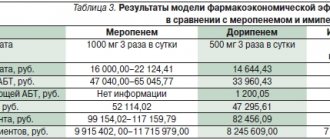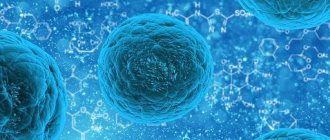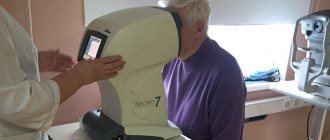Imipenem and Cilastatin Jodas 500 mg + 500 mg 20 ml No. 10 bottle
Content
Indications Contraindications With caution Use during pregnancy and breastfeeding Method of administration and dosage Elderly patients Impaired liver function For children, the following dosage regimen is recommended: Side effects Overdose Storage conditions Expiration date
Indications
The drug "Imipenem and Cilastatin Jodas" for intravenous administration is used in the treatment of severe infections caused by microorganisms sensitive to it, as well as for empirical treatment of the infectious process even before its bacterial pathogens are identified. The drug "Imipenem and Cilastatin Jodas" for intravenous administration is indicated for the treatment of:
- Lower respiratory tract infections caused by Streptococcus pneumoniae, Staphylococcus aureus (penicillinase-producing strains), Acinetobacter spp., Enterobacter spp., Escherichia coli, Haemophilus influenzae, Haemophilus parainfluenzae, Klebsiella spp., Serratia marcescens;
- Urinary tract infections (complicated and uncomplicated) caused by Enterococcus faecalis, Staphylococcus aureus (penicillinase-producing strains), Enterobacter spp., Escherichia coli, Klebsiella spp., Morganella morganii, Proteus vulgaris, Providencia rettgeri, Pseudomonas aeruginosa;
- Intra-abdominal infections caused by Enterococcus faecalis, Staphylococcus aureus (penicillinase-producing strains), Staphylococcus epidermidis, Citrobacter spp., Enterobacter spp., Escherichia coli, Klebsiella spp., Morganella morganii, Proteus spp., Pseudomonas aeruginosa, Bifidobacterium spp., Clostridium spp. ., Eubacterium spp., Peptococcus spp., Peptostreptococcus spp., Propionibacterium spp., Bacteroides spp., including Bfragilis, Fusobacterium spp.;
- Gynecological infections caused by Enterococcus faecalis. Staphylococcus aureus (penicillinase-producing strains), Staphylococcus epidermidis, Escherichia coli, Streptococcus agalactiae (group B streptococci), Enterobacter spp., Gardnerella vaginalis, Klebsiella spp., Proteus spp., Bifidobacterium spp., Peptococcus spp., Peptostreptococcus spp., Propionibacterium spp., Bacteroides spp., including B.fragilis;
- Bacterial septicemia caused by Streptococcus pneumoniae, Enterococcus faecalis, Staphylococcus aureus (penicillinase-producing strains), Enterobacter spp., Escherichia coli, Klebsiella spp., Serratia spp., Bacteroides spp., including B.fragilis, Pseudomonas aeruginosa;
- Infections of bones and joints caused by Enterococcus faecalis, Staphylococcus aureus (penicillinase-producing strains), Staphylococcus epidermidis, Enterobacter spp., Pseudomonas aeruginosa;
- Skin and soft tissue infections caused by Streptococcus pyogenes, Enterococcus faecalis, Staphylococcus aureus (penicillinase-producing strains), Staphylococcus epidermidis, Acinetobacter spp., Citrobacter spp., Enterobacter spp., Escherichia coli, Klebsiella spp., Morganella morganii, Proteus vulgaris, Providencia rettgeri, Pseudomonas aeruginosa, Serratia spp., Peptococcus spp., Peptostreptococcus spp., Bacteroides spp., including B.fragilis, Fusobacterium spp.;
- Infectious endocarditis caused by Staphylococcus aureus (penicillinase-producing strains);
- To prevent postoperative infections in patients at risk with a high probability of developing a postoperative infectious complication, as well as in patients with a high risk of intraoperative infection during surgery.
Contraindications
Hypersensitivity to any of the components of the drug, other beta-lactam antibiotics, penicillins and cephalosporins.
- Children under 3 months.
- Children with impaired renal function (serum creatinine more than 2 mg/dl).
- Patients with creatinine clearance less than 5 ml/min/1.73 m2.
Carefully
Pseudomembranous colitis.
- Patients with a history of gastrointestinal diseases.
- Patients with creatinine clearance <70 ml/min/1.73 m2.
- Patients on hemodialysis.
- Patients with diseases of the central nervous system.
Use during pregnancy and breastfeeding
No studies have been conducted in pregnant women. The drug should be used during pregnancy only if the benefit to the mother justifies the potential risk to the fetus.
Imipenem is found in human breast milk. If the use of the drug is considered necessary, then breastfeeding should be stopped.
Directions for use and doses
THE DOSAGE FORM FOR INTRAVENOUS USE SHOULD NOT BE ADMINISTERED INTRAMUSCULARLY.
The calculation of the total daily dose of Imipenem and Cilastatin Jodas should be based on the severity of the infection and distributed over several applications in equal doses, taking into account the degree of sensitivity of one or more pathogenic microorganisms, renal function and body weight.
The average therapeutic daily dose is 1-2 g of imipenem, divided into 3-4 applications. For the treatment of moderate infections, the drug can also be used at a dose of 1g twice a day.
In the case of infections caused by less sensitive microorganisms, the daily dose of the drug for intravenous infusion can be increased to a maximum of 4 g (imipenem) per day or 50 mg/kg per day, whichever dose is lower. Each dose of Imipenem and Cilastatin Jodas for intravenous infusion, less than or equal to 500 mg, should be administered intravenously over 20-30 minutes. Each dose over 500 mg should be administered intravenously over 40-60 minutes. Patients who experience nausea during the infusion should slow down the rate of drug administration.
Elderly patients
For elderly patients with normal renal function, no dose adjustment is required.
Liver dysfunction
For patients with impaired liver function, no dose adjustment is required.
Prevention: dosage regimen for adult patients
For the prevention of postoperative infections in adults, the drug "Imipenem and Cilastatin Jodas" for intravenous infusion should be administered at a dose of 1 g during induction of anesthesia and then 1 g after 3 hours. For high-risk surgery (eg, colon and rectal surgery), two additional doses of 500 mg should be administered 8 and 16 hours after induction of anesthesia.
Dosage schedule for children from 3 months of age
For children, the following dosage regimen is recommended:
- Children weighing 40 kg should receive the same doses as adult patients.
- Children over 3 months old and weighing less than 40 kg should receive the drug at a dose of 15 mg/kg at 6-hour intervals. The maximum daily dose should not exceed 2 g.
The drug "Imipenem and Cilastatin Jodas" is not recommended for the treatment of meningitis. If meningitis is suspected, appropriate antibiotics should be prescribed.
Preparation of solution for intravenous infusion
The drug "Imipenem and Cilastatin Jodas" for intravenous infusion cannot be mixed or added to other antibiotics.
The dosage form of the drug "Imipenem and Cilastatin Jodas" for intravenous infusion is chemically incompatible with lactic acid (lactate) and should not be prepared on the basis of solvents containing lactate. However, the intravenous drug "Imipenem and Cilastatin Jodas" can be administered through the same infusion system as the solution containing lactate.
The solution of the drug "Imipenem and Cilastatin Jodas" for intravenous infusion is prepared in accordance with Table 4 below. The final infusion solution must be shaken until a clear solution is obtained. The color of solutions of the drug "Imipenem and Cilastatin Jodas" varies from colorless to yellow (color changes within these limits do not affect the activity of the drug).
For 20 ml bottle
In the bottle with the drug "Imipenem and Cilastatin Jodas" you must first add 10 ml of the appropriate solvent from the list presented in Table 5. The resulting primary suspension must be thoroughly shaken and added to an infusion bottle containing 90 ml of infusion solvent.
PRIMARY SUSPENSION SHOULD NOT BE USED FOR ADMINISTRATION.
To completely transfer the drug, the procedure must be repeated by adding 10 ml of the previously obtained solution from the infusion bottle to the bottle with the remaining powder. The resulting suspension must be shaken thoroughly and added to an infusion bottle containing 90 ml of infusion solvent.
The total volume of solvent is 100 ml.
The final infusion solution must be shaken until a clear solution is obtained.
Side effects
- Infectious and parasitic diseases: pseudomembranous colitis, candidiasis, gastroenteritis.
- From the blood and lymphatic system: eosinophilia, pancytopenia, neutropenia, leukopenia, thrombocytopenia, thrombocytosis, agranulocytosis, hemolytic anemia, inhibition of the red line of the bone marrow.
- From the immune system: anaphylactic reactions.
- From the psyche: mental disorders, including hallucinations and states of confusion.
- From the nervous system: convulsions, myoclonus, dizziness, drowsiness, encephalopathy, paresthesia, tremor, taste perversion, exacerbation of myasthenia gravis, headache, agitation, dyskinesia.
- From the organ of hearing and labyrinthine disorders: hearing loss, vertigo, ringing in the ears.
- Cardiac disorders: cyanosis, tachycardia, palpitations.
- Vascular disorders: thrombophlebitis, decreased blood pressure, hot flashes.
- From the respiratory system, chest and mediastinal organs: shortness of breath, hyperventilation, sore throat.
- From the gastrointestinal tract: diarrhea, vomiting, nausea, staining of teeth and/or tongue, hemorrhagic colitis, abdominal pain, heartburn, glossitis, hypertrophy of the tongue papillae, hypersalivation.
- From the liver and biliary tract: liver failure, hepatitis, fulminant hepatitis.
- From the skin and subcutaneous tissues: rash (including exanthematous), urticaria, itching, toxic epidermal necrolysis, angioedema, Stevens-Johnson syndrome, erythema multiforme, exfoliative dermatitis, hyperhidrosis, changes in skin structure.
- Musculoskeletal and connective tissue disorders: polyarthralgia, pain in the thoracic spine.
- From the kidneys and urinary tract: acute renal failure, oliguria/anuria, polyuria, change in urine color (safe and should not be mistaken for hematuria). The role of Imipenem and Cilastatin Jodas in changes in renal function is difficult to assess because other factors predisposing to prerenal azotemia or deterioration of renal function are usually present.
- From the genital organs and breast: genital itching.
- General disorders and disorders at the injection site: fever, pain and induration at the injection site, erythema at the injection site, chest discomfort, asthenia/weakness.
- Laboratory indicators: increased activity of serum transaminases, increased activity of alkaline phosphatase, positive direct Coombs test, increased prothrombin time, decreased hemoglobin, increased serum bilirubin concentration, increased serum creatinine concentration, increased blood urea nitrogen concentration.
Overdose
Symptoms of overdose are consistent with the adverse reaction profile and may include convulsions, confusion, tremor, nausea, vomiting, decreased blood pressure, and bradycardia. There is no specific information on the treatment of overdose of Imipenem and Cilastatin Jodas. Imipenem - cilastatin sodium is eliminated during hemodialysis, but the effectiveness of this procedure in case of drug overdose is unknown.
Storage conditions
Store at a temperature not exceeding 30°C.
Keep out of the reach of children.
Best before date
3 years.
Enter
Carbapenems are beta-lactam antibiotics with an ultra-broad spectrum of antibacterial activity, which includes most clinically important aerobic and anaerobic bacteria. This power stinks especially strongly as the first choice drugs for the empirical treatment of serious infections in hospitalized patients, in which microorganisms that cause infection are unknown or its resistance is suspected.
Nina has two carbapenems. Imipenem/cilastatin has been in clinical practice for more than 10 years. Meropenem is becoming available in a growing number of countries. These antibiotics retain their activity against an increasing number of bacterial strains, such as beta-lactamases. Both drugs are similar in effectiveness, but have different structural, physicochemical, pharmacodynamic and pharmacokinetic influences, which may be more important for their clinical stability. This article is devoted to a review of the significant functions and follows the clinical evidence of the stagnation of both drugs, with particular attention paid to dosage and nutritional safety.
Antibacterial activity and spectrum of activity
Chemical structure and mechanism of action.
The difference in the chemical structure between the meropenem and the same ensures the stability of the meropenem to nitric dehydropeptidase and enhances its activity against
Pseudomonas aeruginosa
.
Activity in vitro.
Meropenem and imipenem have a wide antibacterial spectrum, and the number of pathogens is sensitive to both antibiotics. Prote activity of the meropenem against gram-negative aerobes and anaerobes in 2-16 types of tissue, lower activity in the stomach, while the remaining action is 2-4 times more effective than the meropenem on the gram-positive microorganisms organisms, and staphylococci and enterococci themselves.
Although for penicillin-resistant pneumococci it is necessary to increase the MIC value (minimum inhibitory concentration) to the same measure, they are still not sensitive to carbapenems.
Bacterial resistance.
Resistance to carbapenems was observed in a very small number of bacterial species, leading to some fatal clinical effects of imipenem/cilastatin.
Stenotrophomonas (Xanthomonas) maltophilia, Enterococcus faecium
and most methicillin-resistant staphylococci are resistant to carbapenems.
The faulty persistence up to the hour of treatment was mainly observed in P. aeruginosa
.
Meropenem is active against this microorganism in vitro
and is no longer active against some immune-resistant strains.
Meropenem has also been shown to be active in vitro
against
Burkholderia (Pseudomonas) cepacia
, a microorganism that is considered to be resistant to imepenem.
The name and action are not affected by the action of the TEM enzyme, which is carried by plasmids (often found in Enterobacteriacea
), including extended-spectrum beta-lactamases, which are increasing in frequency and developing resistance to cephalosporins.
In addition, carbapenems do not contain chromosomal beta-lactamases, which are often detected in Enterobacter, Serratia marcescens
and
Pseudomonas
.
Visnovki
Over the past 10 years, imipenem/cilastatin has highlighted the role of carbapenems as effective broad-spectrum monotherapy for serious bacterial infections. The main undesirable effects of imepenem/cilastatin—toxic release on the central nervous system and side effects on the side of the thyroid gland—can be avoided by maintaining it in certain patients and changing the method of administration. Meropenem, a new drug in this class of antibiotics, is better tolerated, and therefore expands the formulation of carbapenems for the treatment of meningitis and allows the dose to be increased to 6 g / day. At that time, when concern about the resistance to antibiotics increases, the activity of carbapenems is no longer even high.
Prepared by Bogdan Boris
Evidence of the use of carbapenems in pediatrics
Randomized, consistent studies of more than 1000 infants and children demonstrated that the intervention was as effective and well tolerated as cefotaxime and ceftriaxone for treatment of meningitis, and effective, as a combined regimen based on cefotaxime for the treatment of various other infections, does not languages from the central nervous system (Bradley JS et al., 1996). There are no indications for consolidation in children over 3 months in most countries, and the drug is approved for consolidation.
In the United States, imepenem/cilastatin has no indication for the treatment of infections in children under 12 years of age, although in other countries the drug can be administered to children over 3 months. To date, no major pediatric studies on imipenema/cilastatin have been published, Nalin and Jacobsen (1987) reported their findings on the treatment of 61 children: 9 patients (15%) went to trial (as a side effect of the drug), although in 6 of them The judges were careful even before the drug was administered.
Carbapenem has no indication for use in newborns and there is no data on the effectiveness of the measure. Pharmacokinetic studies of Vikonane for meropenem demonstrated improved volume distribution and lower elimination rates, which is explained by the physiological characteristics of this group of patients. Single doses that were well tolerated in the study population were doses of 10, 20 and 40 mg/kg.
Two recent articles reported evidence of the impeachment's imprisonment. In a retrospective study, Stuart et al. (1995) reported their data on 80 silent creatures. Only 2 patients suffered from suicide, both of whom had little information about the history of suicide before treatment. However, in a study of 53 silent animals (Scharf J. et al., 1994), trials were observed in 6 patients, and pathological changes in electroencephalograms were recorded in 10 other patients.


